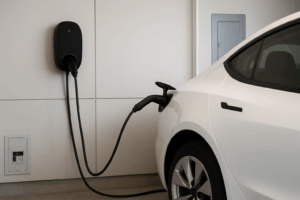Transitioning to an electric vehicle comes with the need to rethink how and where you fuel your ride, and that starts with setting up a charger at home. We will explore how careful planning and safe installation can ensure your charging system works efficiently and reliably. One of the first decisions is choosing the correct location. For homeowners, this typically means the garage or a covered outdoor area near the vehicle is parked. The charger must be positioned where it’s easily accessible but protected from water exposure and excessive heat. Access to a nearby electrical panel also significantly affects installation ease and cost. If your panel is in the garage or close to where the charger will be installed, fewer upgrades and less cabling may be required. Trenching or conduit may be necessary for more distant panels, which adds time and expense. Thoughtful location planning helps minimize costs and ensures a safe, long-term setup.
Planning the Right Location and Power Access
- Understanding Power Requirements and System Capacity
Setting up an electric vehicle charger isn’t as simple as plugging it into any outlet. Most home EV chargers require a dedicated 240-volt circuit, like an electric dryer or oven. The power available in your current electrical panel must be evaluated to determine whether it can support the additional load. Electricians conduct a load calculation to see if your panel has enough spare capacity or if it needs to be upgraded. If space is limited or the system is already close to capacity, a subpanel might be added near the installation site to balance the demand. The amperage of the charger—often 30 to 50 amps—also determines how quickly your vehicle will charge. A higher-amp unit offers faster charging but draws more power, which may require heavier gauge wiring and a larger breaker. Understanding how your home’s electrical system interacts with the charger ensures everything runs safely and efficiently.
- Permits, Codes, and Professional Installation
Even though a charger might seem like a minor addition, installing one must comply with local building codes and electrical safety standards. This often includes securing a permit and arranging an inspection after the work is complete. Permitting requirements vary by city or county, but the process ensures that the installation meets safety criteria and won’t compromise your home’s electrical infrastructure. Licensed electricians are familiar with these codes and make sure the charger is mounted at the correct height, uses proper grounding techniques, and has dedicated wiring to avoid shared circuits. Installation typically involves adding a new breaker, running conduit or cable to the charger location, and securing the unit on the wall. Weather-resistant materials are used to protect the components if the charger is outside. Inspections help verify the system was correctly installed and can safely handle repeated charging cycles. A smooth permitting process and quality work ensure your charger is reliable and safe for years.
- Integrating Smart Charging Features and Scheduling Tools
Modern electric vehicle chargers often come with smart features that allow you to control charging remotely, monitor energy usage, and take advantage of off-peak electricity rates. These features not only add convenience but can also help reduce your monthly utility bills. Wi-Fi-enabled Chargers allow you to manage your vehicle’s charging schedule through a smartphone app, often coordinating with your power company’s lower-rate windows overnight. Some units even integrate with solar systems or home energy storage, helping you further reduce dependence on the grid. Load balancing features can also prevent overloading your system if multiple high-energy devices are running simultaneously. A well-planned Electric vehicle charger setup should consider these options during installation, especially if future expansion is likely. This includes making room on the panel, running conduit that allows for upgrade flexibility, and positioning the charger where signal strength and accessibility align. These forward-thinking steps help maximize both function and efficiency over the long term.
- Budgeting for Cost and Long-Term Value
Installing an EV charger involves upfront costs based on your chosen unit, its distance from the electrical panel, and whether any upgrades are needed. Basic installations where the panel is close to the charger location can be relatively affordable, while those requiring trenching, subpanels, or panel replacements will cost more. The unit itself may range from a few hundred dollars for a simple plug-in charger to over a thousand for a bright, wall-mounted version with high amperage. Labor adds to that cost, but it’s worth the investment for safe and compliant work. Some utilities and local governments offer rebates or tax credits that can offset a portion of the cost. These incentives may also require specific types of chargers or permit documentation, so it’s worth researching them before purchasing. Over time, the cost savings of charging at home instead of at public stations and potential energy efficiency improvements often justify the initial expense.
Installing an electric vehicle charger at home is more than a convenience—it’s essential to owning an EV and maximizing its efficiency and usability. A well-executed installation provides fast, reliable charging that fits your schedule and saves you time. With thoughtful planning, attention to system capacity, and integration of smart features, you can build a setup that supports your needs today and adapts to tomorrow’s advancements. From evaluating the correct charger to navigating codes and making space in your panel, each step contributes to a safer and more effective charging experience. As EV adoption grows, more homeowners will take on this transition, making the charger not just an accessory but a core component of a modern home. By approaching the project carefully, you ensure that your investment in clean energy is supported by dependable infrastructure—turning your garage into a fueling station built for the future. Also, the fuel storage tanks can be a prime solution for you to follow the above future plan.






